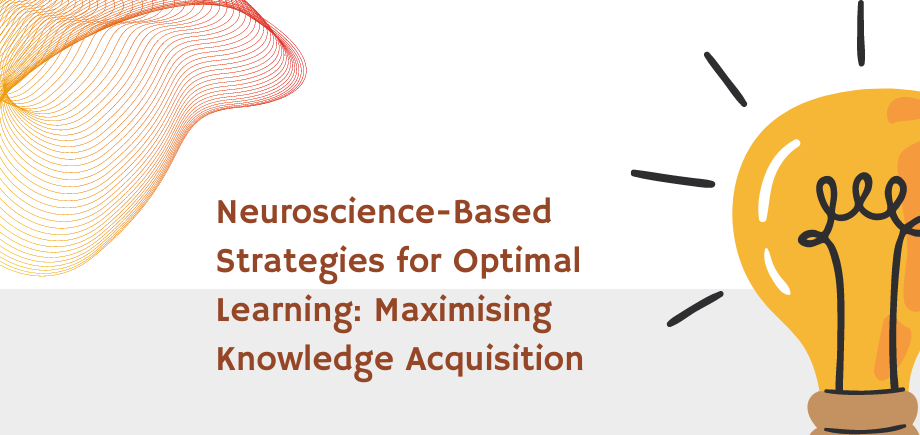Neuroscience-Based Strategies for Optimal Learning: Maximising Knowledge Acquisition using Maslow’s Hierarchy of Needs
In the realm of learning and development, understanding the influence of neuroscience is vital for designing effective training programs. Incorporating neuroscience-based strategies can create engaging learning experiences that enhance knowledge acquisition and retention. In this blog, we will explore the significant role of neuroscience in learning and provide practical techniques for maximising learning outcomes based on Maslow’s Hierarchy of Needs.
Neuroscience, or the study of the brain and nervous system, provides valuable insights into how learners acquire, retain, and apply knowledge. By integrating neuroscience principles, such as neuroplasticity, memory formation, attention, and emotions, we can tap into the brain’s capacity for change and design learning experiences that promote neural growth and enhance skill acquisition. Additionally, neuroscience sheds light on the impact of stress, sleep, and environment on learning outcomes, empowering professionals to create brain-friendly environments that optimise learning.
While Maslow’s Hierarchy of Needs is not a new concept, when considered an interconnected framework with neuroscience, it provides valuable insights into human behaviour and the learning process. Neuroscience explores the underlying neural mechanisms that drive our physiological and psychological needs. At the same time, Maslow’s Hierarchy of Needs outlines the progressive levels of human needs that must be fulfilled for individuals to reach self-actualisation. By understanding the neuroscience behind these needs, learning professionals can tailor their training programs to address the specific requirements of learners at each level of the hierarchy.
Below, we will explore how to apply Maslow’s Hierarchy of Needs to learning and provide practical tips for learning and development professionals to create an optimal learning environment.
Physiological Needs
At the base of Maslow’s Hierarchy are physiological needs, which include basic requirements such as food, water, sleep, oxygen, and warmth. Learners may struggle to concentrate and engage in the learning process when these needs are unmet.
Meeting physiological needs:
- Provide regular refresher breaks during training sessions, allowing learners to rest and recharge.
- Ensure access to water throughout the session, promoting hydration and maintaining energy levels.
- Create a comfortable and suitable learning environment, considering factors like temperature, lighting, and seating arrangements.
- In face-to-face training, offer healthy food options that nourish learners and support their cognitive function.
- For online learning, communicate the flexibility for learners to eat or drink during the session and schedule refresher breaks accordingly.
Safety Needs
Safety needs involve creating a sense of physical and psychological security. Learners need to feel safe and protected in their learning environment to focus on acquiring knowledge.
Meeting safety needs:
- Establish clear guidelines and rules for behaviour, fostering a safe and respectful learning atmosphere.
- Provide a physically safe environment, ensuring that the learning space is free from hazards.
- Address concerns and provide support for learners who may be experiencing anxiety or discomfort.
- Offer opportunities for learners to collaborate and share their thoughts and ideas in a non-judgmental environment.
Social Needs
Social needs refer to the desire for a sense of belonging, acceptance, and connection with others. Human interaction and a positive social environment significantly impact the learning process.
Meeting social needs:
- Encourage collaboration and group activities to foster interaction and teamwork among learners.
- Create opportunities for learners to build relationships and connect with one another, such as through icebreaker activities or group discussions.
- Promote a supportive and inclusive learning culture where learners feel valued and respected.
Esteem Needs
Esteem needs involve the desire for recognition, respect, and a sense of accomplishment. When learners feel appreciated and confident, they are more likely to engage actively in the learning process.
Meeting esteem needs:
- Provide constructive feedback and recognition for learners’ achievements and progress.
- Encourage learners to set personal learning goals and celebrate their accomplishments.
- Foster a growth mindset by emphasising that mistakes are opportunities for learning and improvement.
Self-actualisation
Self-actualisation is the pinnacle of Maslow’s Hierarchy, representing the fulfilment of one’s potential and the pursuit of personal growth. Learners can reach this level by engaging in meaningful and challenging learning experiences.
Meeting self-actualisation needs:
- Support learners in setting and achieving ambitious learning goals that align with their aspirations.
- Design learning activities that promote critical thinking, problem-solving, and creativity.
- Offer opportunities for learners to explore their interests and passions within the learning content.
By leveraging neuroscience and Maslow’s Hierarchy of Needs, learning professionals can create comprehensive and tailored training programs that prioritise learners’ well-being and enhance engagement, retention, and application of knowledge. This holistic approach ensures that learners’ physiological, safety, social, esteem, and self-actualisation needs are met, resulting in a more impactful and fulfilling learning experience. By embracing the intersection of neuroscience and Maslow’s Hierarchy, professionals can unlock learners’ full potential and foster a culture of continuous growth and development.





